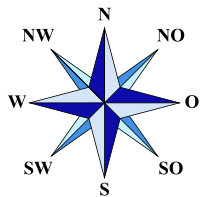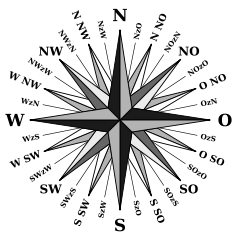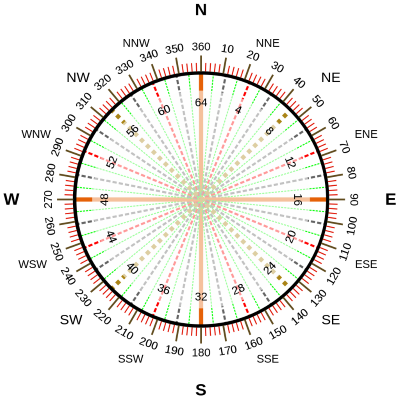Basics of Navigation
| Site: | Open Flight School |
| Course: | Theory Basic Course |
| Book: | Basics of Navigation |
| Printed by: | Guest user |
| Date: | Saturday, 20 December 2025, 1:33 AM |
1. Points of the Compass
1.1. Cardinal Points
Main Cardinal Points
These are the four points of the compass with their clockwise abbreviations:
- North (N),
- East (E),
- South (S),
- West (W)
 Minor Points
Minor Points
For a more precise indication of direction there is the following point between the main cardinal points:
- Northeast (NE)
- Southeast (SE)
- Southwest (SW)
- Northwest (NW)
North and south are always in the name before west (W) and east (E).
 Fine Subdivision
Fine Subdivision
In order to be able to give an even finer indication of the direction, a combination of the names of the main and secondary cardinal points is formed in this order: NNE = north-northeast, ESE = east-southeast, etc.
- north northeast (NNO)
- East Northeast (ONO)
- East Southeast (OSO)
- Southeast (SSO)
- Southwest (SSW)
- West Southwest (WSW)
- West Northwest (WNW)
- Northwest (NNW)
There are even finer specifications (shown in the image). In practice, however, these are not used for virtual flying.
2. Clock Code

Relative direction is often referred to by the hours of a clock. 12 o'clock is always ahead, 6 o'clock is always astern the aircraft. 3 o'clock is to the right and 9 o'clock to the left.
Pilots often use this form of direction indication to indicate a direction of view (relative bearing). However, it is never used to indicate a direction to fly, i.e. A course.
Example of a visual contact report:
"Contact, Left, 11 o'clock, high, far."
This tells a wingman where to look to see the contact. In the example here, slightly to the left of the flight direction, slightly upwards and quite far away. So he will have to look carefully to see the contact.
The problem lies in the inaccuracy when the reference point (i.e. the reporter’s own location) is not absolutely clear. If the wingman flies a slightly different heading, he also looks somewhere else, although he looks into the correct clock code.
3. Bearings in Degrees

When quoting a course in degrees, it is assumed that the full circle corresponds to 360 degrees, as is usual with a protractor. North is therefore both 000 (zero) and 360 degrees. South is always at 180 degrees. The east corresponds to 90 degrees and the west to 270 degrees. These bearings function like cardinal points and are unique and identical to compass data like south or southwest.
But, degrees can also be used in relation to one's own position and flight direction. A change of course BY 10 degrees is slightly different from a change of course to 10 degrees. Therefore, in aviation, course information is always given as a new heading (given by 3 separate digits) and never as an angle of change.
E.G. "Fly heading Three Two Zero"
4. Navigation per Sicht
Das Thema wird später hier hinzugefügt.
